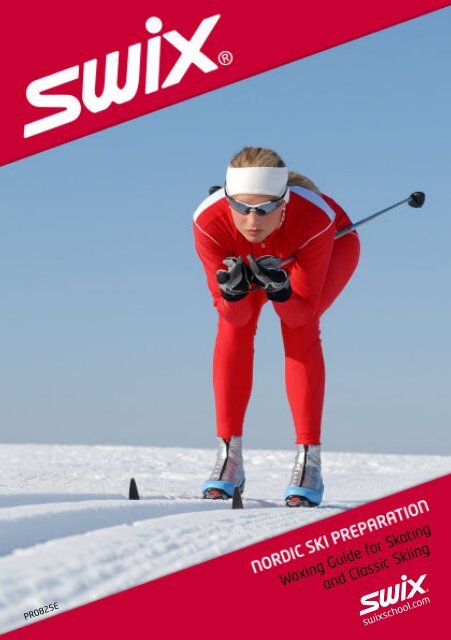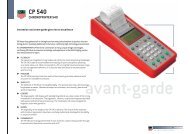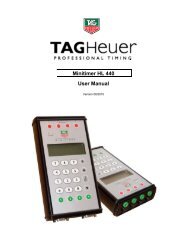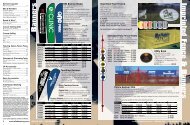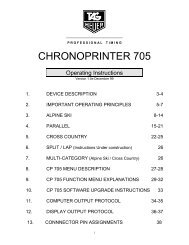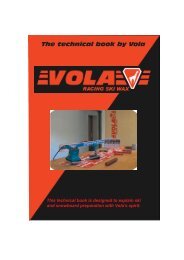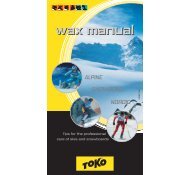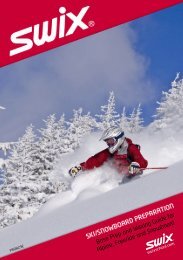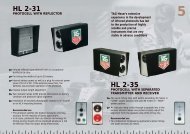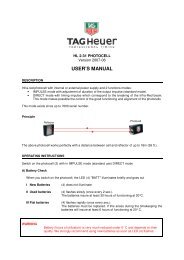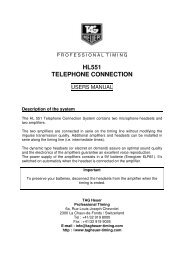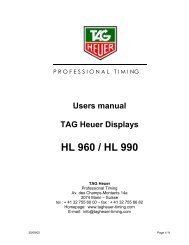Swix Wax Guide - Reliable Racing
Swix Wax Guide - Reliable Racing
Swix Wax Guide - Reliable Racing
You also want an ePaper? Increase the reach of your titles
YUMPU automatically turns print PDFs into web optimized ePapers that Google loves.
PR0825E<br />
<strong>Wax</strong>ing <strong>Guide</strong> for Skating<br />
and Classic Skiing
This manual is not directed towards World Cup racers,<br />
but rather to frequent skiers keen to keep in shape.<br />
<strong>Wax</strong>ing profile T0769<br />
with legs T79-1<br />
Fibertex T266N for<br />
removal of oxidation<br />
on new ski bases<br />
<strong>Wax</strong>ing Iron T74220<br />
Base Cleaner I63N with<br />
fibertex applicator<br />
Plexi Scraper T823 for<br />
removing glide wax<br />
Bronze Brush T162B for<br />
brushing the glider out<br />
of the base structure<br />
Fiberlene Cleaning<br />
Towel T151<br />
Groove Scraper T87<br />
Combi Cork T11 with<br />
sandpaper to be used<br />
on the kick zone<br />
Ski straps R402<br />
<strong>Wax</strong> Scraper T85<br />
2 SWIX SPORT - NORDIC SKI PREPARATION
Founder of <strong>Swix</strong>, Martin Matsbo (1911-2002)<br />
testing kick wax in 1946.<br />
<strong>Swix</strong> takes pride in its more than 50 year history<br />
as one of the strongest and most recognized brand<br />
names in skiing.<br />
Followed by pioneering research work in 1946,<br />
the Astra Pharmaceutical Company introduced<br />
revolutionary ski waxes based upon fully synthetic<br />
materials. The new 3-colored system was a breakthrough<br />
for all skiers, and de-mystified and<br />
simplified waxing. The new <strong>Swix</strong> system of waxing<br />
replaced unscientific and often secret concoctions<br />
of tar, beeswax, melted bicycle tire inner rubes and<br />
phonograph records, to mention just a few of the<br />
obscure ingredients. Before long, <strong>Swix</strong> waxes were<br />
discovered the world over, and recreational skiers<br />
and racers alike realized a new level of enjoyment<br />
and success.<br />
Since 1986 <strong>Swix</strong> has been located in Lillehammer,<br />
Norway where all wax production takes place.<br />
This is an ideal area for testing and developing<br />
new products having close access to cross country<br />
trails and alpine areas.<br />
Traditionally famous for its XC-waxes, today <strong>Swix</strong><br />
is also the number one alpine ski wax company.<br />
We are present at all big events on the World Cup<br />
for cross-country, alpine and snowboard. The most<br />
important markets are Japan, Russia, USA and the<br />
Nordic Countries. <strong>Swix</strong> is owned by the industrial<br />
group FERD.<br />
Follow the guidelines found in this manual<br />
and we can promise better and more<br />
enjoyable skiing.<br />
SWIX SPORT - NORDIC SKI PREPARATION 1
NEW SKATING SKIS/CLASSIC SKIS GLIDEZONES<br />
T266N<br />
CH10<br />
T74220<br />
T87<br />
T88<br />
T408<br />
T823<br />
T162B<br />
1. Base conditioning<br />
The preparation of new skis starts with Fibertex<br />
treatment (T265), 8-10 passes in both directions<br />
along the base. Polyethylene hairs and micro-burrs<br />
are removed, and the base surface is “opened” for<br />
better glide wax absorption.<br />
NB! Only in the glide zones.<br />
2. Hot wax Cleaning<br />
Cleaning by hot-waxing and scraping using a soft<br />
wax, removes dirt and saturates the base.<br />
Recommended are warm temperature waxes such<br />
as CH10, CH8 or BP99. The temperature of the<br />
waxing iron should not exceed 120°C.<br />
Note: No glide wax in the kick zone.<br />
3. Ironing<br />
Start at the tip moving the iron towards the tail in<br />
a continuous movement to prevent overheating<br />
of the base.<br />
4. Groove scraping<br />
While the wax is still warm, remove all wax out of<br />
the groove and on the side-edges with the Scraper<br />
(T87 or T88). Do this before scraping the base to<br />
prevent scratches if the groove scraper unintentionally<br />
happens to jump out of the groove.<br />
5. Base scraping<br />
Scrape off the wax with a sharp Plexi Scraper<br />
(T823) while the wax is still warm (wax-cleaning<br />
method). Do not press too hard. Keeping the<br />
scraper sharp means light strokes can be used to<br />
remove the excess wax without harming the base.<br />
T408 keeps the Plexi Scraper sharp.<br />
6. Brushing<br />
Use a Bronze Brush (T162) tip to tail 10-20 times.<br />
Note: No brushing in the kick zone.<br />
7. Finally, use a soft wax, such as CH8, to saturate<br />
the base to prevent dry bases and to give optimal<br />
glide. Repeat the process two times from Step 2<br />
to 6, but let the skis cool to room temperature<br />
(15 minutes), before Step 4, 5 – Scraping.<br />
Skis having a new stone grind should be trated<br />
also as from step 1 to 7.<br />
2 SWIX SPORT - NORDIC SKI PREPARATION
GLIDE WAX FOR THE DAY FOR SKATING SKIS/CLASSIC SKIS GLIDEZONES<br />
Three glide waxes will cover most snow conditions:<br />
CH8 (or LF8) for normal winter conditions from +1°C to -4°C (34°F to 25°F),<br />
CH10 (or LF10) for wet snow (free water), and<br />
CH7 (or LF7) for cold snow.<br />
1. Base conditioning<br />
Before the application of actual wax for the day,<br />
make 4 or 5 passes with the Bronze Brush (T162) to<br />
re-new and clean the base, ensuring maximum wax<br />
absorption.<br />
T74220<br />
2. Hot wax application<br />
Set the <strong>Wax</strong>ing Iron to the recommended temperature<br />
shown on the wax package. The waxes should<br />
easily melt. Let the wax drip onto base, holding the<br />
iron approx. 5 cm above the ski.<br />
Remember: No glide waxes in the kick zone of<br />
Classic skis!<br />
T87<br />
3. Ironing<br />
Go from tip to tail, constantly moving the iron to<br />
prevent over-heating the base. Let the skis cool for<br />
5 to 10 minutes.<br />
T88<br />
4. Groove scraping<br />
Remove all wax out of the groove with the Groove<br />
Scraper (T87 or T88).<br />
T408<br />
T823<br />
5. Base scraping<br />
Scrape the base with a sharp Plexi Scraper (T823).<br />
Do not press too hard. T408 keeps the Plexi<br />
Scraper sharp.<br />
T162B<br />
6. Brushing<br />
Brush the base with a Bronze Brush (T162) from tip<br />
to tail approx. 20 times. This will remove wax from<br />
the base structure (grinding pattern) to give better<br />
glide.<br />
Note: Do not brush in the kick zone of Classic<br />
skis.<br />
SWIX SPORT - NORDIC SKI PREPARATION 3
<strong>Swix</strong><br />
Glide <strong>Wax</strong>es<br />
CH AND LF CATEGORIES<br />
Three glide waxes are sufficient to obtain good<br />
glide on most snow conditions: CH10 (or LF10) for<br />
very wet snow from +10°C to 0°C (50°F to 32°F),<br />
CH8 (or LF8) in normal winter-conditions from +1°C<br />
to -4°C (34°F to 25°F), and CH7 (or LF7) for colder<br />
than -4°C (25°F).<br />
Note: All <strong>Swix</strong> temperatures are air<br />
temperatures in the shade.<br />
CH7 Violet<br />
Cold snow. -2°C (28°F) and<br />
colder.<br />
Recommended iron setting: 135°C (275°F).<br />
LF7 Violet<br />
Fluorocarbon Glide <strong>Wax</strong>. -2°C<br />
and colder (28°F and colder).<br />
For cold conditions and high<br />
humidity.<br />
Recommended iron setting: 135°C (275°F).<br />
CH8 Red<br />
For normal winter conditions.<br />
+1°C to -4°C (34°F to 25°F).<br />
Also for saturating the bases of<br />
new skis. Will always improve<br />
the glide, even beyond its ideal<br />
range.<br />
Recommend iron setting: 120°C (250°F).<br />
LF8 Red<br />
Fluorocarbon Glide <strong>Wax</strong>. +1°C to<br />
-4°C (34°F to25°F). For normal<br />
winter conditions and high air<br />
humidity. The fluorocarbon<br />
additive definitely improves glide<br />
around the freezing point and<br />
moist snow.<br />
Recommended iron setting: 120°C (250°F).<br />
CH10 Yellow<br />
For very wet snow (free water in<br />
the snow). +10°C to 0°C (50°F to<br />
32°F). Often used to saturate the<br />
bases of new skis due to its<br />
softness and penetration<br />
potential.<br />
Recommended iron setting: 110°C (230°F).<br />
LF10 Yellow<br />
Fluorocarbon Glide <strong>Wax</strong>. +10°C<br />
to 0°C (50°F to 32°F). For very<br />
wet snow. The fluorocarbon<br />
additive will improve glide and<br />
increase dirt resistance.<br />
Recommended iron setting: 110°C (230°F).<br />
4 SWIX SPORT - NORDIC SKI PREPARATION
TREATMENT OF THE KICK ZONE<br />
The stiffness of the skis is very important for<br />
obtaining the combination of good glide and<br />
good kick. Take care when selecting skis.<br />
For optimal function of the kick waxes, accurate<br />
matching of ski stiffness to skier weight is necessary.<br />
At the moment of kick, having full weight on<br />
one ski, the ski should have sufficient contact with<br />
the snow. However, skis that are too soft will reduce<br />
the gliding properties and cause unnecessary wear<br />
of the kick wax. Reputable ski shops will have good<br />
methods and instruments to match ski stiffness to<br />
body weight.<br />
The waxing of the kick zone should take place after<br />
finishing the glide zones. The length of the kick zone<br />
should be in the range of 75 cm for both klister and<br />
hard wax. Generally the kick zone is measured from<br />
the heel of the binding and forward.<br />
Don’t be afraid to extend the kick zone forward if<br />
the skis are slipping. A longer kick zone has less<br />
influence on glide than what you might imagine,<br />
and having good kick will make the ski tour much<br />
more enjoyable.<br />
KICK ZONE (KLISTER=HARD WAX)<br />
70 - 75 cm<br />
ski<br />
180 cm<br />
60 - 65 cm<br />
ski<br />
180 cm<br />
SWIX SPORT - NORDIC SKI PREPARATION 5
APPLICATION OF HARD WAXES<br />
T11<br />
1. Sanding<br />
The kick zone should first be sanded with #100 grit<br />
sandpaper approx. 60 cm (about 2 feet). Sand the<br />
zone back and forth parallel to the length of the ski.<br />
The <strong>Swix</strong> Combi <strong>Wax</strong>ing Cork (T11) with sandpaper<br />
on one side is an ideal tool.<br />
V30<br />
2. Base wax<br />
At temperatures below 0°C (32°F) a relatively hard<br />
wax, such as V30 Blue, is recommended as a basewax.<br />
Base Binder VG35 is applied as the first layer<br />
when the snow becomes coarser.<br />
VG35<br />
3. Ironing base wax<br />
The first layer of wax should be ironed into<br />
the base. The heat will improve the bond between<br />
the wax and base giving longer wear. Iron setting<br />
should be 100°C (212°F).<br />
T74220<br />
V40<br />
VR45<br />
4. Hard wax application<br />
The actual hard wax should be applied in 4-5 thin<br />
layers, smoothing each layer with the cork.<br />
Above freezing and wet snow 2 layers are sufficient.<br />
Note: Leave 2 cm (1 inch) at each end of the kick<br />
zone. With corking, the wax is expanded into these<br />
areas.<br />
5. Corking<br />
Corking in between each layer of wax.<br />
T10<br />
6 SWIX SPORT - NORDIC SKI PREPARATION
<strong>Swix</strong> Hard <strong>Wax</strong>es<br />
The V-line is made both for racing and ski touring.<br />
The high quality is due to high-grade raw materials<br />
and proven formulas that are continually adjusted<br />
to improve effectiveness.<br />
Along with the two temperature ranges shown on<br />
the label are two snow-type symbols. One for new<br />
and falling snow, and one for older, fine grained<br />
snow.<br />
Note: All temperatures given on <strong>Swix</strong> waxes<br />
are air temperatures measured in the shade.<br />
New fallen snow<br />
-8°C to -15°C (18°F to 5°F)<br />
Old, transformed snow<br />
-10°C to -18°C (12°F to 0°F)<br />
<strong>Wax</strong>ing for new snow and fine grained snow<br />
On new snow a harder (colder) wax is applied than<br />
on older snow. The reason for this is that new snow<br />
crystals are sharper and have better penetration<br />
into the wax giving better kick. Older snow particles<br />
are more rounded and a softer wax is needed to get<br />
sufficient kick.<br />
Therefore <strong>Swix</strong> has introduced a system showing<br />
two different temperature intervals on all waxes,<br />
one for the new snow and one for the older snow.<br />
This makes it easier to find the right wax. Do not be<br />
concerned about applying a wax that is one step<br />
“warmer” than what the temperature is indicating if<br />
the snow has become coarser. Normally the snow<br />
transforms from new to fine grained after a couple<br />
of days, although this process might happen faster<br />
close to 0°C (32°F).<br />
V20 GREEN<br />
New fallen snow<br />
-2°C to -10°C (28°F to 14°F)<br />
Old, transformed snow<br />
-5°C to -15°C (23°F to 5°F)<br />
New fallen snow<br />
0°C to -1°C (32° to 30°F)<br />
Old, transformed snow<br />
-1°C to -3°C (30°F to 27°F)<br />
V30 BLUE<br />
V50 VIOLET<br />
V40 BLUE EXTRA<br />
New fallen snow<br />
-1°C to -7°C (30°F to 19°F)<br />
Old, transformed snow<br />
-3°C to -10°C (27°F to 12°F)<br />
V55 RED SPECIAL<br />
New fallen snow<br />
+1°C to 0°C (34°F to 32°F)<br />
Old, transformed snow<br />
0°C to -2°C (32°F to 28°F)<br />
V45 VIOLET SPECIAL<br />
New fallen snow<br />
0°C to -3°C (32°F to 27°F)<br />
Old, transformed snow<br />
-2°C to -6°C (28°F to 21°F)<br />
V60 RED/SILVER<br />
New fallen snow<br />
+3°C to 0°C (38°F to 32°F)<br />
Old, transformed snow<br />
+1°C to -1°C (34°F to 30°F)<br />
SWIX SPORT - NORDIC SKI PREPARATION 7
<strong>Swix</strong> VR Hard <strong>Wax</strong>es (Krystal Line)<br />
• Wider ideal range<br />
• Better glide<br />
• Reduced risk of<br />
icing-up<br />
The VR waxes are fluorinated and formulated for<br />
top racing, but also have proved interesting for<br />
recreational and sport skiers because of their<br />
excellent properties, particularly around 0°C (32°F).<br />
These hard waxes are characterized by a high<br />
degree of flexibility. Each VR-wax has two specified<br />
temperature ranges, one for falling and new fallen<br />
New fallen snow<br />
-7°C to -20°C (19°F to -4°F)<br />
Old, transformed snow<br />
-10°C to -30°C (14°F to -22°F)<br />
VR30 LIGHT BLUE<br />
Designed for cold to extremely cold conditions.<br />
New fallen snow<br />
+1°C to 0°C (34°F to 32°F)<br />
Old, transformed snow<br />
0°C to -4°C (32°F to 25°F)<br />
VR50 VIOLET<br />
Designed for moist to dry snow around freezing 0°C<br />
(32°F). When used below freezing, the snow must<br />
be transformed.<br />
New fallen snow<br />
-2°C to -8°C (28°F to 18°F)<br />
Old, transformed snow<br />
-4°C to -12°C (25°F to 10°F)<br />
VR40 BLUE<br />
For normal, subfreezing temperatures.<br />
New fallen snow<br />
+2°C to 0°C (36°F to 32°F)<br />
Old, transformed snow<br />
0°C to -3°C (32°F to 27°F)<br />
VR55 SILVER/VIOLET<br />
For moist snow around freezing and for older,<br />
more coarse snow just below freezing.<br />
Perfect balance between kick and glide.<br />
New fallen snow<br />
0°C to -2°C (32°F to 287°F)<br />
Old, transformed snow<br />
-2°C to -8°C (28°F to 18°F)<br />
VR45 FLEXI<br />
Light violet. A flexible wax for temperatures around<br />
freezing and colder.<br />
New fallen snow<br />
+2°C to 0°C (36°F to 32°F)<br />
Old, transformed snow<br />
+1°C to -2°C (34°F to 28°F)<br />
VR60 SILVER<br />
Designed for moist snow. When used below freezing<br />
high humidity and transformed snow is required.<br />
8 SWIX SPORT - NORDIC SKI PREPARATION
snow, characterized by sharp snow crystals with<br />
relatively strong penetration capacity, and one<br />
range for older snow, when the crystals are more<br />
rounded and have less penetration power.<br />
NOTE: All <strong>Swix</strong> temperatures are air<br />
temperatures in the shade.<br />
New fallen snow<br />
0°C to +3°C (32°F to 38°F)<br />
Old, transformed snow<br />
+1°C to -1°C (34°F to 30°F)<br />
VR65 RED/YELLOW/SILVER<br />
For moist snow. Excellent wax on fresh slightly wet<br />
to moist snow.<br />
New fallen snow<br />
+1°C to +3°C (34°F to 38°F)<br />
Old, transformed snow<br />
0°C to +2°C (32°F to 36°F)<br />
VR70 KLISTERWAX<br />
Red. For wet and moist new snow. Works also<br />
on wet transformed snow down to 0°C (32°F).<br />
Apply thicker if very wet.<br />
New fallen snow<br />
+2°C to +5°C (36°F to 41°F)<br />
VR75 KLISTERWAX SOFT<br />
Yellow. For wet snow, glazy tracks. Must be applied<br />
evenly. To be used in maintained tracks only.<br />
SWIX SPORT - NORDIC SKI PREPARATION 9
APPLICATION OF KLISTERS<br />
Klisters are generally used when the snow<br />
has gone through one or more cycles of<br />
thawing and refreezing, or when very wet.<br />
T11<br />
1. Sanding<br />
Sand the kick zone with #100 sandpaper<br />
(or T11 Combi-Cork).<br />
2. Base Klister<br />
KR20 or KB20 Green is normally chosen as the first<br />
layer as a base. Apply in a thin layer, just covering<br />
the sanding. For lower temperatures, high tear and<br />
wear conditions, or long distances always use KR20<br />
or KB20.<br />
KR20 KB20<br />
3. Ironing Base Klister<br />
The first layer of klister should be carefully warmed<br />
into the base with an iron to improve the contact<br />
between the klister and base.<br />
Let the skis cool to room temperature.<br />
T74220<br />
4. Klister application<br />
Select and apply the klister of the day. One layer<br />
normally is enough. The product is applied in a<br />
“fish-bone” like pattern, or as a thin string on each<br />
side of the groove.<br />
KR50 K22N<br />
5. Smoothing the Klister<br />
Distribute evenly with the scraper, found in<br />
the package, or with the hand.<br />
T87<br />
10 SWIX SPORT - NORDIC SKI PREPARATION
<strong>Swix</strong> Universal Recreation Klisters<br />
Frozen corn (old) snow<br />
Transformed moist<br />
fine grained snow<br />
Wet corn snow<br />
K21N Silver Universal Klister<br />
+3°C to -5°C (37°F to 23°F).<br />
For coarse to fine grained snow and<br />
changing conditions around freezing.<br />
To be used on somewhat colder conditions<br />
than K22N VM Universal<br />
Klister.<br />
Frozen corn (old) snow<br />
Wet corn snow<br />
K22N VM Universal Klister<br />
+10°C to -3°C (50°F to 27°F).<br />
For coarse grained to fine grained<br />
snow, with an ideal range somewhat<br />
above freezing.<br />
How to get good glide and great kick -<br />
Try <strong>Swix</strong> School at<br />
www.swixschool.com<br />
Always available and free of charge!<br />
SWIX SPORT - NORDIC SKI PREPARATION 11
<strong>Swix</strong> KR Klister (Krystal Line)<br />
A complete line of klisters, ranging from very cold<br />
and coarse snow to extreme wet conditions.<br />
Designed for top-level performance, but useful for<br />
recreational touring skiing as well.<br />
Frozen corn (old) snow<br />
KR20 BASE KLISTER<br />
Green. -3°C to -25°C (27°F to -13°F).<br />
High wear resistance and adhesion.<br />
To be used as a first layer as a binder<br />
for other klisters or hard waxes in very<br />
abrasive conditions. Can also be used<br />
alone for icy conditions at very cold<br />
temperatures. As a first layer klister,<br />
it should be heated into the base.<br />
Frozen corn (old) snow<br />
Transformed moist<br />
fine grained snow<br />
Wet corn snow<br />
KR50 FLEXI KLISTER<br />
Violet. +3°C to -4°C (37°F to 25°F).<br />
Very adaptable, working on both sides of<br />
freezing. Ideally it is best when conditions are<br />
changeable and mixed fine grained snow.<br />
Frozen corn (old) snow<br />
KR30 ICE KLISTER<br />
Blue. 0°C to -15°C (32°F to 5°F).<br />
For frozen, icy tracks in cold<br />
conditions. Can also be used as<br />
a base klister for wet-snow klisters<br />
to improve wear.<br />
Transformed moist<br />
fine grained snow<br />
Wet corn snow<br />
KR60 VARIO KLISTER<br />
Red. +5°C to 0°C (41°F to 32°F).<br />
Created for medium wet snow.<br />
“Vario” is best on the warm side<br />
of freezing.<br />
Frozen corn (old) snow<br />
Wet corn snow<br />
KR40 COARSE SNOW KLISTER<br />
Violet/blue. +2°C to -7°C (36°F to<br />
19°F). A tough klister for old granular,<br />
coarse snow only. Great base klister<br />
with VR50 and VR45 on top when<br />
the snow is coarse at -2°C /-5°C<br />
(28°F /23°F).<br />
Wet corn snow<br />
KR70 AQUA KLISTER<br />
Red. +12°C to +2°C (52°F to 36°F).<br />
Wet snow klister. Used when the snow<br />
has high water content such as slush,<br />
and the air temperature is well above<br />
freezing.<br />
12 SWIX SPORT - NORDIC SKI PREPARATION
Cleaning of Skis<br />
Cleaning is recommended after each ski trip.<br />
1. Scraping<br />
Remove as much wax as possible using<br />
a scraper (T87).<br />
T87<br />
I62<br />
T151<br />
I63N<br />
2. Final Cleaning<br />
The remainder is taken away with <strong>Wax</strong> Remover<br />
and Fiberlene (T0150). If the wax is difficult to<br />
remove, use gray Fibertex (T265) saturated in Base<br />
Cleaner.<br />
The Base Cleaner I63N has a coarse applicator that<br />
efficiently removes klister.<br />
<strong>Swix</strong> Base Cleaner (I64)<br />
The active ingredient in the cleaner is<br />
a low aromatic hydrocarbon with good<br />
solvent capacity.<br />
Citrus Solvent Base Cleaner (I74)<br />
500 ml Citrus Solvent is a 100% citrusbased<br />
product, which also is a strong<br />
solvent.<br />
Klister Scrubber (T269)<br />
Use together with Base Cleaner<br />
for efficiently removal of klister.<br />
Base Cleaners and accessories for<br />
removal of hard waxes and klisters<br />
<strong>Wax</strong>es and klisters consist of tough, rubbery, waterresistant,<br />
inert, and stable materials. This means<br />
that they are also difficult to remove from the ski<br />
base. Solvents are necessary for thorough base<br />
cleaning.<br />
<strong>Swix</strong> Base Cleaner and <strong>Swix</strong> Citrus Solvent are both<br />
formulated to minimize health and fire hazards.<br />
Traditional solvents like trichloroethylene or<br />
methylenechloride were frequently used as solvents<br />
for oils, fats and also waxes. These highly aromatic<br />
solvents, however, are considered health hazards<br />
and should be avoided. They are not found in the<br />
<strong>Swix</strong> wax removers.<br />
Fiberlene Cleaning Towel<br />
40 m.<br />
SWIX SPORT - NORDIC SKI PREPARATION 13
NEWS!<br />
Liquid Grip Line<br />
The new <strong>Swix</strong> Liquid Grip <strong>Wax</strong>es inherit their<br />
qualities from the traditional V-series of waxes<br />
including the famous “V40 Blue Extra”. The three<br />
waxes in the Grip Line are the solution for dedicated<br />
skiers demanding a fast and clean product with<br />
reliable kick qualities.<br />
The new Liquid Grip Line includes V40L Blue,<br />
V50L Violet and V60L Red, and are used for new and<br />
fine grained snow conditions. These liquid V-products<br />
come in convenient packaging.<br />
V40L Blue Grip<br />
-2°C to -15°C<br />
(28°F to 5°F).<br />
Liquid wax covering<br />
a wide range on the<br />
cold side in new and<br />
fine grained snow<br />
conditions.<br />
70 ml/2.5 fl. oz.<br />
V50L Violet Grip<br />
0°C to -3°C<br />
(32°F to 27°F).<br />
Liquid wax covering<br />
the range on the cold<br />
side below freezing in<br />
new and fine grained<br />
snow conditions.<br />
70 ml/2.5 fl. oz.<br />
V60L Red Grip<br />
0°C to +3°C<br />
(32°F to 38°F).<br />
Liquid wax covering<br />
the range on the<br />
warm side above<br />
freezing in new and<br />
fine grained snow<br />
conditions.<br />
70 ml/2.5 fl. oz.<br />
Liquid Glide Line<br />
New formula! Easy application, dries quickly and time saving!<br />
F6L Blue Glide<br />
-4°C to -15°C<br />
(25°F to 5°F).<br />
Fluorinated liquid wax<br />
with wide range on the<br />
cold side. For all snow<br />
types.<br />
80 ml/2.8 fl.oz.<br />
F7L Violet Glide<br />
+1°C to -6°C<br />
(34°F to 22°F).<br />
Fluorinated liquid wax<br />
with wide range around<br />
freezing. For all snow<br />
types.<br />
80 ml/2.8 fl.oz.<br />
F8L Red Glide<br />
0°C to +10°C<br />
(32°F to 50°F).<br />
Fluorinated liquid<br />
wax for all wet snow<br />
conditions.<br />
80 ml/2.8 fl.oz.


